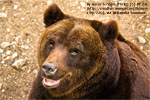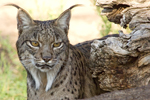In Central Italy, one hundred kilometers from Rome, a small group of 50 brown bears lives in complete isolation. This study, based on whole genome sequencing, reveals an extraordinary and complex history of population decline and isolation, random accumulation of deleterious mutations, active maintanance of variation at immune and olfactory genes, and morphological and behavioural divergence. Genomic data suggest that bears in Europe lost connectivity about 3-4,000 years ago, when early farmers burnt forests for land clearing. This was a large scale human-mediated environmental change, which left profound signatures on several species, as the fragmentation of a large European brown bear population and its local demographic collapse in Central Italy. A consequence of this collapse is the desolating landscape of extremely low genetic variation observed in the Apennine bear, charaterized also by several potentially deleterious mutations shared by all the analyzed individuals and rarely found in other populations. These are the negative effects produced by chance (random genetic drift) in small populations and are considered as the main drivers of extinction. Loss of genetic diversity is also particularly harmful if a population faces fast environmental changes. So, the question is: how could the Apennine bears have resisted for such a long time at very low population size and be apparently in good shape? Surprisingly, few genomic regions with very high diversity stand out from the low and flat background characterizing the rest of the genome. These regions, whose variation can be as high as in other European bears, are enriched for immunity and olfactory receptor genes. The authors believe this is evidence of an active process maintaining high genetic diversity where variation is mostly needed, i.e. at genes responsible for the complex interactions with the external environment both as defence from pathogens and as perception of smells. Balancing selection, a special form of natural selection favouring individuals with two different copies (ie. alleles) of the same gene, seems the most likely explanation. This study also shows that random fixation of rare and usually disadvantageous mutations can produce interesting evolutionary outcomes in small populations, such as smaller size and reduced aggressiveness. In particular, the authors discovered in the Apennine bear a significant divergence at genes that were associated with a shift to a more docile behaviour in other mammal species. Such mutations, likely accumulated by chance, could have produced the less aggressive behaviour often observed in the Apennine bear. Attacks on men are not recorded in historic times and this rather docile behaviour may have prevented persecution and eradication by local human communities. In other words, it seems that the diffusion of some mutations, although clearly disadvantageous in other circumstances, could have turned into a bless for the Apennine bear. In conclusion, the Apennine bear seems to have some cards to resist and keep fighting its evolutionary battle against genomic meltdown, despite the extremely small population size and the clear genetic consequences of their long history of inbreeding. The endangered Apennine bear requires constant monitoring, but it also represents a beautiful natural experiment that teaches us a lot about the delicate balance between natural selection and chance in small populations. informacion[at]ebd.csic.es: Benazzo et al (2017) Survival and divergence in a small group: the extraordinary genomic history of the endangered Apennine brown bear stragglers. Proc Natl Acad Sci USA doi: 10.1073/pnas.1707279114
http://www.pnas.org/content/early/2017/10/23/1707279114.abstract


 Fifty bear stragglers in Italy resist genomic meltdown
Fifty bear stragglers in Italy resist genomic meltdown
